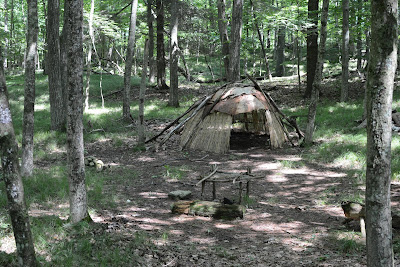We were quite busy in the RV Park ramping up for the Fourth of July festivities. Since then, we have been, by my guess, running about 80% occupancy during the week and pretty much full on weekends. My major Projects have been whittled down to getting the doors in the Bathhouse/Laundry cleaned up and painted. Winter has been brutal and the doors have taken a beating. Lots of rust and pitting that has to be sanded before primer can be applied. Then I found that one coat of primer was not enough so had to add a second. Add to the mix the fact that it has been the wettest summer in recent memory, I have had to work around rain. It's taking forever to get this one project completed!! I hope I'm finished by the time we are ready to leave!

We did, finally, take some time to be a tourist. One day we took a trip just up the road to the Cana Island Lighthouse. Built in 1869 and first lit in 1870, the light on this island has witnessed much of the history of Great Lakes shipping. There are many shipwrecks resting in the waters around Cana Island, both wooded hull and modern vessels. The light is a third order Fresnel lens that originally burned lard or whale oil. In 1945 it converted to electricity using a generator and batteries. In the 1960's an electric power line was installed. The lamp was converted to a 110 volt, 200 watt bulb on a unique rack. There are four bulbs on this rack which is designed to rotate and automatically replace a bulb in case of failure. It is still an active navigational aid to this day.

As the name implies, the lighthouse is located on an island. Access to the island is via a tractor pulled wagon. There is a natural stone causeway that is just under the surface of the lake. It looks like you are driving off into the depths but you just splash across, all the while being regaled by facts and stories by your driver.
 |
| Another tour group approaches |
 |
| The view over the drivers shoulder |
A 102 step circular staircase leads to the top of the lighthouse tower. The light itself is about 85 feet above the water and can be seen for 18 miles. It is different from many lighthouses in that the light beam is directed outward constantly. By that I mean there is no rotation of the light causing the familiar blinking pattern. It is solid all through its illumination cycle.
 |
| Looking up the staircase |
 |
| Inside the light. |
In the photo above, you are looking inside the Fresnel lens at the light source itself. The small box in the center of the picture is the four bulb rotating device. You can see two of the bulbs on either side of the box. They are incredibly small considering that their light can be seen for 18 miles out! Just shows the power of the Fresnel lens design.
 |
| The view from the top. |
 |
| Walking along the shoreline of Lake Michigan at Whitefish Bay |
On another day, we took a trip to Whitefish Dunes State Park. Here the sand dunes line a stretch of Whitefish Bay. The dunes are among the highest in the state and are not common place. In fact they occur only in a few locations in Wisconsin lakeshore. Several trails line the beach and have been used by various human populations for about 3,000 years.

Trails meander through beaches, wooded thickets, and open meadows. Benches are placed periodically so you can sit and watch/listen to the sights and sounds of nature.
There is a mock up of an early tribal village. This showed how things would have looked 1,000 years ago in this area.
Adjacent to Whitefish Dunes is Cave Point County Park. Here is dramatic evidence of a limestone shelf that extends all around Lake Michigan and on eastward all the way to Niagara Falls. This park is well known to locals but many tourists don't even know it exists. There is no admission fee and the trail has some spectacular views.
For the brave (or foolhardy), there are opportunities to jump off cliffs to the waters below. All along the shoreline erosion has carved out caves and depression pools that lure the daredevils.
Along a stretch of open shoreline, rocks of all shapes and sizes have been tossed by wave action. Here people build what I call HooDoos. We have seen similar structures all throughout our travels. You start with a big rock platform and each passerby selects a rock and places it on the base. As time goes on you have the various towers. Superstition says that bad luck will come to you if you knock over a tower, either on purpose or by placing your rock on it. Conversely, good luck will come to you after you balance your rock on a tower. Not sure if it's true, but I did build several towers just to cover my bases!!



























